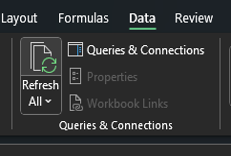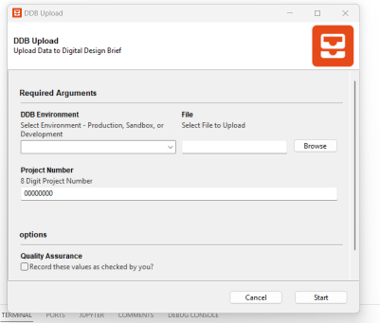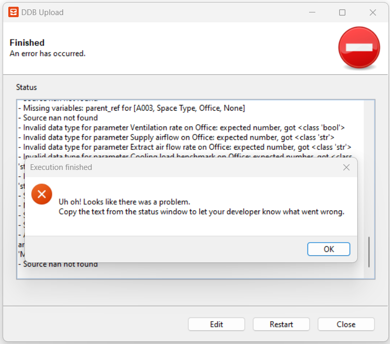# DDB Upload Tool ⬆️
The DDB Upload Tool simplifies uploading data to DDB by allowing uploads of Assets, Parameters, Sources, and Tags using an Excel Template.
Note: You will need to have an Arup GitHub license to access the Upload Tool and Excel Template (opens new window). You may see a 404 error if you do not have a license. Please contact [email protected] and request a license.
# Upload Tool User Guide
# Excel Upload Spreadsheet
You can find the Excel Template and the Application file here (opens new window) with instructions included on the first tab and as comments on the tables.
# Updating Reference Data
Excel Template uses reference data to populate the drop-down lists. To update the data:
- Open the Excel Template.
- Click on
Enable Contentat the top of the file. This will allow you to refresh the reference data. - Under the
Datatab, click onRefresh All. This will update the reference data which is used in the drop down lists.

# Worksheet Guide
# DDB Upload Settings
 No changes to this tab are needed unless you want to rename sheets or tables, or add additional tabs. You can have multiple of each tab type.
No changes to this tab are needed unless you want to rename sheets or tables, or add additional tabs. You can have multiple of each tab type.
The DDB Upload Settings sheet tells the application what data you have and where to find it. There are three Table Types (Sources, Data, Tags) and this sheet is used to indicate which tabs and tables contain each data type.
# Sources
 The Sources sheet allows you to create sources. Within DDB, the source of all our information is identified. These sources have types, dates, and references (where applicable) assigned to them.
The Sources sheet allows you to create sources. Within DDB, the source of all our information is identified. These sources have types, dates, and references (where applicable) assigned to them.
Fill in all your sources of information so they can be used when you upload Parameters.
# Example Data
 This is an example of the Data sheet and contains Assets, Parameters and Tags that the application will upload. Each row represents an Asset and each column represents a Parameter.
This is an example of the Data sheet and contains Assets, Parameters and Tags that the application will upload. Each row represents an Asset and each column represents a Parameter.
Each key row and column has a comment with more information about what is required and links to additional resources.
# Project Data

This is the tab where most of your work will take place.
The Project Data sheet is empty and allows you to upload Assets, Parameters and Tags. Each row represents an Asset and each column represents a Parameter.
Each key row and column has a comment with more information about what is required and links to additional resources.
Use the Example Data tab to help you fill in this sheet.
# Upload Tags
 To avoid the need to list tags on every Asset and Parameter, you can use the Upload Tags sheet, which automatically tags every Asset, Parameter and the Project being uploaded with the requested tag.
To avoid the need to list tags on every Asset and Parameter, you can use the Upload Tags sheet, which automatically tags every Asset, Parameter and the Project being uploaded with the requested tag.
# Upload Tool Executable
The executable is an application that allows you to run a Python script without needing to have Python installed.
The Tool has several inputs:
DDB Environment - Select the environment your DDB Project is in.
File - Select the Excel Template. This needs to be saved, but does not need to be closed.
Project Number - Input the Project number linked to your DDB Project. This should be in the format 00000000, with no dashes.
Optional inputs:
- Quality Assurance -If you have permissions, you can tick this box and automatically mark uploaded data as checked.
# How to run the script
Open the Executable file by clicking on it in the file explorer. It may take a few moments to load.
You should then see this interface.

Once you have added your inputs, click Start to begin.
You should be able to monitor the progress of the upload tool and see any data errors in the console.
If all your data uploads correctly, you should see this message:

# Addressing Data Errors
If your data has errors in it, the upload tool will identify them for you to correct. You will see this message.

Click OK and read through the detailed list of issues with your data. These may include:
- Missing Values (e.g. a missing Asset name)
- Sources not being linked correctly (e.g. inputting a Source in your Project Data that does not exist in the Sources sheet)
- Invalid data types (e.g. Putting a string when the data type is a number)
- Units that are not valid (e.g. cm for Ventilation rate) - See the suggested Units
- Asset Sub Types that are not valid (see suggestions)
- If you see an error from the server which contains "no item type relationship", this means that you cannot use that Parameter with that Asset Type. You can see valid Asset and Parameter combinations in the Data Dictionary and can fill in the form to request more (opens new window).
Make the changes to your data, save the spreadsheet and run the tool again. You can simply click Restart.
# Useful Resources
# DDB Data Dictionary
This tool requires an awareness of the DDB Asset Hierarchy. The Data Dictionary is a one-stop-shop Power BI dashboard developed by the DDB team that can be used for exploring what Parameters, Assets, and units are available in DDB.
Read the documentation on the data dictionary for more detail.
# Extra Notes
- This tool will not upload empty values.
- If you post the same information as an existing Asset or Parameter, the tool will not post it to DDB.
- If you change the name of an Asset, the tool will post a new Asset.
- If you update the value, source, or unit of a Parameter, this change is posted to DDB.
- This tool also requires your project to exist in DDB and for you to have permissions on it. Read the documentation on user permissions for more information.
- You can mark all Parameters as already checked and we will also record this for you.